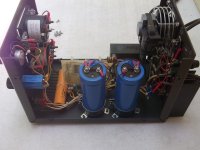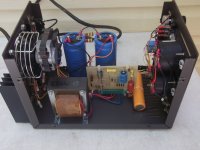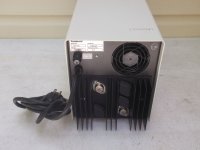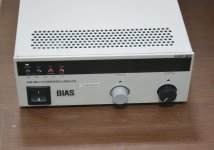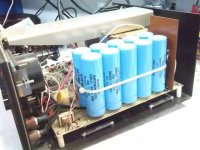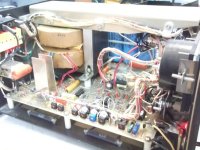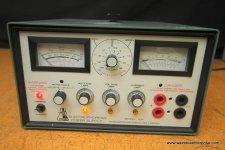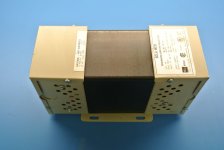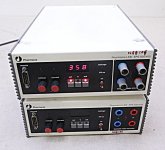I'm guessing your talking about an electrophoresis supply?
Not sure about the particular one you are asking about but some them throw the toys out if you connect the negative terminal to ground.
There is a thread on here about an older type one that has been successfully modified by several people. I don't have a link but believe it was the Isco 494.
Cheers
Matt
Not sure about the particular one you are asking about but some them throw the toys out if you connect the negative terminal to ground.
There is a thread on here about an older type one that has been successfully modified by several people. I don't have a link but believe it was the Isco 494.
Cheers
Matt
Last edited:
I found a listing for this Bio-Rad 500/200 that shows the insides.
Being rated at 500V 0.2A, I guess the xfmr is about the right size for a linear regulated power supply. Odd place for the fan though, unless there are air passage holes under the heatsink.
Did anyone try this for a power supply? A lot cheaper and more capable than the usual Heathkit power supply.
Being rated at 500V 0.2A, I guess the xfmr is about the right size for a linear regulated power supply. Odd place for the fan though, unless there are air passage holes under the heatsink.
Did anyone try this for a power supply? A lot cheaper and more capable than the usual Heathkit power supply.
Attachments
Last edited:
One of my colleagues at work used to be with Bio-Rad, and he says that almost all electrophoresis supplies have circuitry that disables the output unless a load is present. I suppose this was to help prevent lighting up hapless bio-tech types. Anyway, a supply that appears dead might just be looking for a load. 5-10k might be the ticket.
I have one of the Bio-Rad supplies in question in my basement. I've never found a schematic, but it does use an unobtainium Motorola linear IC. If I have time, I might try slinging the lid back on the thing to see if a resistive load will make it perk up. The next step would be to figure out that output disable circuit and disable it.
I have one of the Bio-Rad supplies in question in my basement. I've never found a schematic, but it does use an unobtainium Motorola linear IC. If I have time, I might try slinging the lid back on the thing to see if a resistive load will make it perk up. The next step would be to figure out that output disable circuit and disable it.
Hmm, If you can read the number on that IC, the IC datasheet might give some clue to how the disable circuit works. If the IC is unobtanium, then not so attractive for a bench supply. I got an International Power 250V fixed supply for cheap that was missing the IC, but it was just an LM723.
I'm not sure the IC has anything to do with the disable, just noted in passing that it's in the design and no longer available. The IC had original markings, and I was able to look it up.
I was thinking at one time of stripping out the innards and replacing them with a linear regulator of my own design using either MOSFETs or IGBTs as pass elements. If I can get the supply to basically function, I'll forgo that, as I have better uses for my time. If I remember correctly, the supply functioned on the bench at work when I received it, but not when i got it home. Maybe it was just a question of load...
I was thinking at one time of stripping out the innards and replacing them with a linear regulator of my own design using either MOSFETs or IGBTs as pass elements. If I can get the supply to basically function, I'll forgo that, as I have better uses for my time. If I remember correctly, the supply functioned on the bench at work when I received it, but not when i got it home. Maybe it was just a question of load...
I've never found a schematic, but it does use an unobtainium Motorola linear IC.
The unobtainable Motorola chip is the MC1466 / MC1566. It is a unique floating regulator chip that runs on an separate floating power supply allowing the chip to be used in high voltage / high current power supplies. It was a unique design in the 70's but never became an industry standard part like the 723 regulator. I had several of the chips, but tossed all of that stuff a few years ago when it became obvious that I was going to move.
Motorola made (or had made by a contractor) a line of bench power supplies sold through their repair division, intended for use in a Motorola shop for repairing portable two way radio equipment. These power supplies appeared on the market while I worked in the calibration lab at Motorola (1974 - 1984). We bought a bunch of the "small ones" and modified them by removing the analog voltmeter and adding a digital panel meter. I performed that surgery on several dozen units. The power supplies were quite reliable (unlike some Mot branded test equipment) and rarely blew up despite my abuse. There was a bigger bench supply, but we did not use them in the plant, so I don't know if it has the same chip.
As of about 5 years ago the replacement chips were still available through Mot's National Parts Depot, but you would need the in house part number. Anyone that I know that would be able to help with some info was laid off long before I was, so that's a dead end. All of the old production line test equipment was scrapped years ago when US production ceased. They can still be found at hamfests and sometimes on Ebay.
I tried searching the web to find some leads, like the model number of said power supply without much luck. A manual would have the part number, which will start with 51, but you can't find a manual without the model number.
I did find one of the power supplies still in modified condition for sale on Ebay. It was obviously used inside a Motorola plant. The test equipment control number tag is still present telling me that this particular power supply was used in Plantation Florida, where I worked. Who knows maybe it is one that I modified. Unfortunately the model number is not visible in any of the photos.
Motorola DC Power Supply 20 Volts 10 Amps | eBay
Wow! George that is cool. How come you guys back then chose to use a digital meter for current? I would chose an analogue one to be able to see quickly any change.
I have been gathering parts and building piece's of the mother of all bench supplies for valves/tubes. I decided that I wanted digital meters but also needed the immediately recognisable deflection of an analogue meter. I have built a pair of nixie meters with IN13 bargraph under them to see that S#&* it's going wrong moment.
Cheers
Matt
I have been gathering parts and building piece's of the mother of all bench supplies for valves/tubes. I decided that I wanted digital meters but also needed the immediately recognisable deflection of an analogue meter. I have built a pair of nixie meters with IN13 bargraph under them to see that S#&* it's going wrong moment.
Cheers
Matt
I would have replaced the 1466 circuit with a regulator that floats around the output voltage. This makes voltage and current sensing really easy as long as you can generate a supply for the control circuit referenced to the output voltage. Standard filament transformers are generally specified at 1500V secondary isolation, so they are good candidates for the floating supply. Many years back I threw together a linear bench supply supply like this using a bog-standard 1458 IC for the brains, and it was rock solid. It got replaced with Topward bench supplies that had more output capability.
http://www.bio-rad.com/webroot/web/html/lsr/tech_support_faqs/FAQ268439099.html...almost all electrophoresis supplies have circuitry that disables the output unless a load is present.
^^ I don't remember how I stumbled on that, but I had it burried in a heap of bookmarks "to sort through", it may give some ideas. I work in molecular biology; my lab has about a dozen supplies, the lab I worked in during college had about a dozen of them, and I have two at home. I'm almost certain they won't work without a load, it prevents us biologist from popping the tops off our gel boxes and poking things we shouldn't poke
That said, I have a 250v Bio-Rad and a 3kv Bio-Rad at home and I haven't really tried to get them working. I picked them up from my local university surplus and the following week they had three Heathkit IP-17 supplies for sale so I bought all three of those to use instead. I poked, prodded, and fumbled around a bit with the 3kv supply, but I encountered seemingly quite a few safety features, probably a good thing on that particular supply

Those MC1466/1566 chips seem to be available on Ebay. 295 available, $5 each.
Made in Korea or US, but ship from China.
1pcs IC MC1466L MOT CDIP-14 GOOD QUALITY | eBay
Made in Korea or US, but ship from China.
1pcs IC MC1466L MOT CDIP-14 GOOD QUALITY | eBay
Those ISCO 494 power supplies are still on Ebay. Look a lot more complex. I see a constant voltage xfmr in there, so line V regulated. They are even cheaper than the Bio-Rad, and higher power.
I wonder what tube requires around -600V bias voltage from a 2 Amp supply?
I just got one of these Xantrex XHR 600-2 units in -not working- condition for $120. I usually have good luck getting them to work. But there are several layers of dense circuit boards in there if it's not your lucky day. I see the sense lines connected wrong, some hope.
Speaking of constant V xfmrs (like SOLA CVS, MCR etc type), they have a 600V winding on them for the resonating capacitor, and it is a regulated V (from magnetic saturation) square wave. Would make a nice foundation for a HV power supply. Not too expensive, but you have to add a regulator if you want variable V. (the older CVT type buzz/hum a lot, the newer CVS MCR are quiet)
I wonder what tube requires around -600V bias voltage from a 2 Amp supply?
I just got one of these Xantrex XHR 600-2 units in -not working- condition for $120. I usually have good luck getting them to work. But there are several layers of dense circuit boards in there if it's not your lucky day. I see the sense lines connected wrong, some hope.
Speaking of constant V xfmrs (like SOLA CVS, MCR etc type), they have a 600V winding on them for the resonating capacitor, and it is a regulated V (from magnetic saturation) square wave. Would make a nice foundation for a HV power supply. Not too expensive, but you have to add a regulator if you want variable V. (the older CVT type buzz/hum a lot, the newer CVS MCR are quiet)
Attachments
Last edited:
I have around six electrophoresis supplies of various sorts, including a working Isco 494, a 250V supply from Hoefer, that Bio-Rad 500/200, and a few others including a hulking Dan-Kar 3kV monstrosity that probably has no protection whatsoever. I was interested in a cheap, no-frills supply for evaluating tube amp prototypes. The first one up wins...
I have on my bench at work a Xantrex 600-1.7 - this has been used to check various HV audio projects over the years. At ~$1500, they are definitely too expensive for the casual researcher.
I have on my bench at work a Xantrex 600-1.7 - this has been used to check various HV audio projects over the years. At ~$1500, they are definitely too expensive for the casual researcher.
The previous Xantrex XHR 600 supplies I've gotten were from during the dot-com collapse when sellers couldn't sell used stuff fast enough on Ebay. Non working ones were like $50 to $100 and good ones were around $300 then. Now the Ebay prices look almost like they're for new ones.  (about $1800 new I think)
(about $1800 new I think)
The trick is to find one listed as "not working", but most sellers won't admit to that, they'll just say "not tested". A long search to find one cheap now. I do see Sorensen LHP power supplies (re-labeled Xantrex XHR units) go for cheap occasionally. There are Sorensen XHR supplies too, but people are onto to those as being Xantrex XHRs. A bunch of LHPs went for $29 recently (check sold listings). But those are usually lower voltage models.
The XHR 600 is actually using a HF xfmr with four 150 V windings with rectifiers and caps for each, then series DC connected. So a 150V model could be easily tricked into being a 600V model by rewinding the HF xfmr. A cheap 7V LHP could be converted too, with an xfmr change, but that would require more extensive circuit info to re-do the voltage sensing and current sensing. And there are two sets of those, one for the control circuitry, and another for the front panel meters.
The Xantrex XT250-0.25 supplies show up occasionally for $100 to $120. But those don't solve the HV B+ need. Good for a screen V supply though.
One can find EMI TCR-600 supplies for reasonable prices usually. I've seen them for $50 to $150. They are similar to the HP6448 600V, using a triac 60 Hz phase control. Heavy, probably noisy like the HP, slow regulation. I think the ISCO 494 is a 60 Hz phase control unit too. At least they are efficient.
The trick is to find one listed as "not working", but most sellers won't admit to that, they'll just say "not tested". A long search to find one cheap now. I do see Sorensen LHP power supplies (re-labeled Xantrex XHR units) go for cheap occasionally. There are Sorensen XHR supplies too, but people are onto to those as being Xantrex XHRs. A bunch of LHPs went for $29 recently (check sold listings). But those are usually lower voltage models.
The XHR 600 is actually using a HF xfmr with four 150 V windings with rectifiers and caps for each, then series DC connected. So a 150V model could be easily tricked into being a 600V model by rewinding the HF xfmr. A cheap 7V LHP could be converted too, with an xfmr change, but that would require more extensive circuit info to re-do the voltage sensing and current sensing. And there are two sets of those, one for the control circuitry, and another for the front panel meters.
The Xantrex XT250-0.25 supplies show up occasionally for $100 to $120. But those don't solve the HV B+ need. Good for a screen V supply though.
One can find EMI TCR-600 supplies for reasonable prices usually. I've seen them for $50 to $150. They are similar to the HP6448 600V, using a triac 60 Hz phase control. Heavy, probably noisy like the HP, slow regulation. I think the ISCO 494 is a 60 Hz phase control unit too. At least they are efficient.
Attachments
Last edited:
Yeah, those 60 Hz phase control monsters are good for fireworks. With your tube amp blowing up first, THEN the fuse or circuit breaker popping. Kind of like a "foundation coolers" fire department. One could add a linear current limiter I guess.
I suppose the Bio-Rad has its positive merits with a linear regulator and limiter. But irksome, in that it takes up the space of 2 or 3 XHR supplies. (100 Watts versus 3000+ Watts! and 3 voltages) There has got to be a better cheap solution around.
I suppose the Bio-Rad has its positive merits with a linear regulator and limiter. But irksome, in that it takes up the space of 2 or 3 XHR supplies. (100 Watts versus 3000+ Watts! and 3 voltages) There has got to be a better cheap solution around.
Last edited:
Here we go.
$99, 500V, 400 mA, digital readout, analog V and I knobs, 9.5 lbs, reasonably compact 10" W x 4" H x 17" D (especially if 2 or 3 are stacked ), and looks like it could include a ground fault interrupter (leakage)
(and remote? If it can be programmed for V and I with readbacks, it might be use-able for a PC tube curve tracer?)
There's even one on sale (and working) for just $50! (in Calif.)
I'd like to see what is in these things. With heatsinks making up the case itself and 10 lbs, it could be a linear design, but more likely a HF switcher.
I think I'll get one just to find out.
$99, 500V, 400 mA, digital readout, analog V and I knobs, 9.5 lbs, reasonably compact 10" W x 4" H x 17" D (especially if 2 or 3 are stacked ), and looks like it could include a ground fault interrupter (leakage)
(and remote? If it can be programmed for V and I with readbacks, it might be use-able for a PC tube curve tracer?)
There's even one on sale (and working) for just $50! (in Calif.)
I'd like to see what is in these things. With heatsinks making up the case itself and 10 lbs, it could be a linear design, but more likely a HF switcher.
I think I'll get one just to find out.
Attachments
Last edited:
- Status
- This old topic is closed. If you want to reopen this topic, contact a moderator using the "Report Post" button.
- Home
- Design & Build
- Equipment & Tools
- Bio-Rad 500/200
